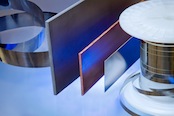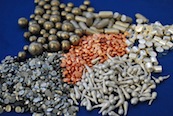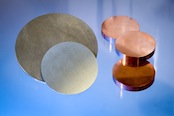Tantalum
Tantalum is one of the refractory metals, so-called for their ability to withstand extremely high temperatures. As a refractory metal tantalum stands out for a combination of high melting point, low ductile-to-brittle transition temperature and corrosion resistance. Tantalum is used for electrolytic capacitors, chemical process equipment such as heat exchangers, condensers, thermowells, and lined vessels, and to produce containers for working with acids including nitric, hydrochloric and sulfuric. Tantalum is also used in heating elements and heat shields, prosthetic devices and surgical staples, and in specialized aerospace, nuclear and military applications.
Typical Properties
Atomic Number: 73
Atomic Weight: 180.95
Atomic Volume: 10.9
Crystal Structure: Body-centered cubic, a = 0.33026
Isotope (Natural): 181
Density at 20 oC, g/cc: 16.6, .600 lb/in3
Melting Point: 2,996 oC
Boiling Point: 5,430 oC
Linear Coefficient of Expansion: 6.5 x 10-6 per oC
Thermal Conductivity at 20 oC: 0.130 cal/cm 2/cm/oC/sec
Specific Heat at 20 oC: 0.036 cal/g/oC
Electrical Conductivity : 13% IACS
Electrical Resistivity at 20 oC: 135.0 nΩ ⋅ m
Temperature Coefficient of Electrical Resistivity(0-100 oC): 0.0038 per oC
Tensile Strength:
at Room Temperature: 35,000-70,000 psi
at 500 oC: 25,000-45,000 psi
at 1000 oC: 13,000-17,000 psi
Young's Modulus of Elasticity:
Room Temperature: 27 x 106 lb/in2
500 oC: 25 x 106 lb/in2
1000 oC: 22 x 106 lb/in2
Poisson's Ratio: 0.35
Thermionic Work Function: 0.657 aJ (4.10 eV)
Magnetic Susceptibility: 0.93 10-6 cgs
Spectral Emissivity: .46 (900 oC) (Wave Length Approx. 0.65 micron)
Total Emissivity:
at 1500 oC: .21
at 2000 oC: .26
Working Temperature: Room temperature
Recrystallization Temperature: 1200 oC - 1400 oC
Stress Relieving Temperature: 850 oC
Thermal Neutron Cross Section: 21.3 b
Polishing: Emery to 000 levigated alumina to finish.
Etchant: Hf-NH4F Solution. Etch and Polish repeatedly until grain boundaries appear.

 ALLOYS
ALLOYS 





